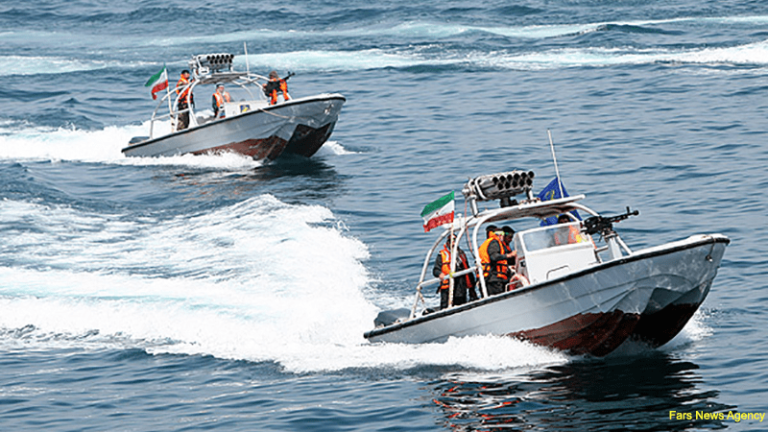
As the new administration of President Donald J. Trump struggles to find its foreign policy footing, with early tests emerging in the Middle East, Asia, Europe, and elsewhere, Iran is looming as the next key challenge to the nascent “Trump Doctrine” in foreign policy. As one White House official put it in early April, “America First is the Trump doctrine”—a position recently reiterated by White House Spokesman Sean Spicer. But what does that mean?
In general, the doctrine mainly appears to consist of tough talk and showy displays of military force intended to goad adversaries and serve immediate tactical and political interests. Overarching strategies remain to be determined. Flexibility and willingness to reverse course suddenly—virtues to some but disconcerting signs of erraticism, even instability, to much of the US foreign policy establishment and many American allies—are key elements as well. No fixed ideology or principles appear to undergird the president’s approach.
What the Trump Doctrine means for US relations with Iran has become a burning question with serious implications for the future of the Arabian Gulf states, Syria, Iraq, Yemen, the United States, and, indeed, the international community as a whole. And here the doctrine’s evolution is well underway.
The Nuclear Deal under the Microscope
During the presidential campaign, Trump was unambiguous in his contempt for the Iran nuclear deal (the Joint Comprehensive Plan of Action, or JCPOA) that was the centerpiece of former President Barack Obama’s regional policy, saying that it was “the worst deal I’ve ever seen negotiated.” He vowed that his “number-one priority is to dismantle the disastrous deal with Iran.” Nevertheless, the administration has since backed away from this approach, both in tone and substance. Trump said in late April only that it is “possible” the United States would not stay in the agreement, complaining mildly of alleged Iranian violations of the JCPOA’s “spirit.” US officials have dropped any mention of tearing up the deal and have instead suggested that Washington would seek to “renegotiate” it with Tehran, an action that has been rejected by Iran as well as by the Europeans and the United States’ JCPOA negotiating partners.
Even renegotiation seems to have been placed on the back burner. For now, the administration acknowledges that the deal is working. Secretary of State Rex Tillerson informed House Speaker Paul Ryan in a required certification letter on April 18 that Iran remains compliant with its obligations under the JCPOA, while making clear that this compliance will remain under intense scrutiny. Tillerson said the National Security Council will direct a comprehensive interagency review to “evaluate whether suspension of sanctions related to Iran pursuant to the JCPOA is vital to the national security interests of the United States,” leaving open the door to reinstatement of unilateral US sanctions.
The Administration’s Growing List of Iranian Threats and What to Do about Them
In remarks at the State Department the day after the letter’s release, Tillerson sharpened his criticism of Iran, making clear that the United States has numerous other concerns that will shape the administration’s approach. In addition to Iran’s nuclear ambitions, he expressed concern about Iran’s support for terrorism and threats against Israel; its ballistic missile activities, which, he alleged, violate UN Security Council resolution 2231; cyber-attacks; threats to navigation in the Arabian Gulf; destabilizing activities in Syria, Yemen, Iraq, and Lebanon; the detention or disappearance of a number of foreign nationals, including American citizens; and Iran’s egregious human rights record.
Tillerson rejected a posture of “strategic patience,” adding that “a comprehensive Iran policy requires that we address all of the threats posed by Iran” and warning that “an unchecked Iran has the potential to travel the same path as North Korea, and take the world along it … The Trump administration has no intention of passing the buck to a future administration on Iran … We will meet the challenges Iran poses with clarity and conviction.”
Given the dire sense of urgency Tillerson communicated, what, then, are the immediate and longer-term options available to the Trump Administration? Several courses of action are possible, the least likely of which is to build on the nuclear accord to improve relations with Tehran, or at least establish a basis for limited regional cooperation, as some commentators have suggested. Troublesome Iranian behavior makes that course both politically unpalatable and a risk to vital US interests.
The administration is thus likely to focus initially on four key lines of action.
First, it will continue to scrutinize the nuclear deal and demand full Iranian compliance. It will also demand exceptional efforts by the United Nations and its relevant agencies, and the International Atomic Energy Agency (IAEA), to be equally vigilant in their scrutiny and generous with information-sharing about Iran’s nuclear plans and programs in public and private. This will help ensure a common front and intelligence picture among the United States, its allies, and the UN and a basis, if necessary, for further action.
Second, it will establish rhetorical deterrence by pointedly putting military action on the table if Iran violates its JCPOA agreements or directly threatens US and allied interests. The thinking is that Iran must be left in no doubt that the president will act, a message the Tomahawks in Syria, a Massive Ordnance Air Blast (MOAB) bomb in Afghanistan, and tough talk against North Korea arguably was intended to impart to Tehran.
Third, the White House will continue vigorously to explore imposition of additional sanctions. As Tillerson made clear, reactivation of sanctions related to Iran’s nuclear program is under consideration as part of the comprehensive policy review the administration has begun. In early February, in response to an Iranian ballistic missile test launch, the White House imposed sanctions on 25 entities and individuals connected to Tehran’s ballistic missile program. Sanctions targeting broader lists of entities and economic sectors that support Iran’s military technology procurement and missile development may be contemplated, as might new sanctions to address Iran’s support for terrorism and destabilizing regional activities. The White House has indicated willingness to work closely with Congress toward this end. Similarly, the United States will have to work with allies to ensure that the international community presents a unified front on existing sanctions and enlist support for new American measures—a very tall order at best.
Fourth, the United States will consider widening its military options. The administration has vowed to respond forcefully to Iranian naval provocations in the Gulf, which contrasts with the Obama Administration’s relatively restrained posture. A more aggressive naval response could extend to Yemen, where Houthi rebels attacked a Saudi warship off the coast in January, reportedly killing two crew members, following attacks in October 2016 on UAE and US naval vessels evidently utilizing anti-ship missiles provided by Iran. Whether to become more deeply involved in the anti-Houthi campaign led by Saudi Arabia will likely be on the table. Consideration of a more aggressive stance in Iraq and Lebanon toward Iranian proxies may also be considered, but the risks there of retaliatory attacks on American troops are quite high.
Looking Beyond the Immediate
Beyond these, the Trump Administration will likely consider additional policy options:
- Improve coordination and intelligence-sharing with and among European and Gulf countries to counteract both Iranian support for terrorism and its malign regional activities.
- Offer increased encouragement, intelligence, military coordination, and other forms of support to the Saudi-organized Islamic Military Alliance to Fight Terrorism, the so-called “Muslim NATO.” The 41-nation force, still under development, is often viewed as a counterweight to Iran, which is likely to appeal to the Trump Administration. The White House may seek to persuade the Gulf states to utilize the force not only to confront “terrorism” per se, but to put Iranian interests in the Gulf region at risk (a tricky proposition given that the Pakistani general named to command the force, Raheel Sharif, has said Iran must be included to ensure the force does not appear “sectarian”).
- Initiate a broader security dialogue with the Gulf states. This may be a productive way for the administration to encourage the type of intelligence and military coordination necessary to form a comprehensive strategy to counteract Iran’s regional ambitions. In this context, the administration may want to encourage wider and more comprehensive discussions between the Gulf states and Iraq to enhance diplomatic and security cooperation. (Such an effort was pursued by the United States without much success since 2006, but it is worth a renewed push in the present threat environment.)
- Work with the United Nations and friendly states to strictly enforce the terms of Annex B to UN Security Council resolution 2231, which prohibits the transfer of large weapons systems by member states to Iran and Iranian arms transfers to other states and parties. Doing so would, in particular, place Russia, which is negotiating a $10 billion arms sale to Iran, in a difficult position and could in theory hinder Tehran’s arms transfers to Houthi rebels in Yemen and Hezbollah in Lebanon.
Playing the Human Rights Card
One area of Iranian misbehavior that does not seem to excite Trump’s interest—Secretary Tillerson’s public remarks to the contrary—is human rights, an issue on which the regime is domestically and internationally vulnerable. Iran’s high rate of executions, use of torture, and arbitrary imposition of harsh punishments on members of ethnic minorities and political dissidents all are part of a broad “crackdown on citizens for the legitimate exercise of their rights, in blatant disregard of international and domestic legal standards.” This is a problem on which Washington and most American allies, especially in Europe, agree. Concerted action to highlight and sanction the regime’s violations of human rights at every opportunity and to pressure Iran in international fora such as the UN Human Rights Council would embarrass the regime, encourage domestic opposition and human rights activists (not to mention political prisoners and their families), and serve as a potential disincentive to international investment.
Dangerous Road Ahead
Each of these approaches, together or separately, combined with the administration’s increasingly hostile rhetoric, will serve to heighten the risk of military confrontation with Iran. Indeed, in response to the imposition of new sanctions in February, Iran launched major military exercises, including tests of missile and radar systems, “to showcase the power of Iran’s revolution and to dismiss the sanctions,” the Iranian Revolutionary Guard Corps website announced. “If we see the smallest misstep from our enemies, our roaring missiles will rain down on them,” the IRGC Air Force commander, General Amir Ali Hajizadeh, vowed.
This hair-trigger atmosphere, hyped by both Washington and Tehran, can only be intensified by Iran’s current domestic political scene. The hard-line cleric Ebrahim Raisi has emerged as perhaps the lead challenger to incumbent President Hassan Rouhani in the May 2017 presidential elections amid discontent with the so-far meager impacts of the nuclear deal on the Iranian economy as well as Iran’s decades-long fears of external threats to the Islamic revolution. In this climate, slight miscalculations on either side could lead quickly to military clashes and potentially a wider conflict involving the United States and its allies, on one side, against Iran and its proxies on the other in Yemen, Iraq, and elsewhere.
Where to, Now?
The slope of the president’s learning curve as he reacts to foreign crises is, by his own admission, steep. “The magnitude of everything is so big, and also the decisions are so big. You know, you’re talking about life and death. You’re not talking about ‘you’re going to make a good deal,’” as Trump told the Wall Street Journal.
As the president learns on the job and expands the “Trump Doctrine” to encompass new international developments, more surprises, miscalculations, sudden policy moves, and reversals are inevitable. Applied to Iran, the “Trump Doctrine” may be a recipe for a dangerous new phase in the decades-long confrontation between the United States and the Islamic Republic.

